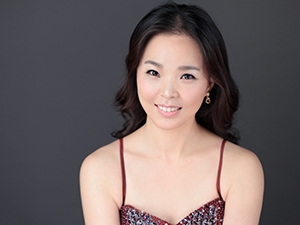Technical standards for pianists have changed in just the thirty-some years since I graduated from conservatory. However, I’m not always certain that musical profundity has kept pace with physiological advances. This is what was brought to mind by the generally fine recital on June 30 by Na Young Kim. She is the chairman of the piano department at Sejong University in Seoul, Korea; and her New York debut was only last year.
Ms. Kim has many attractive qualities as a pianist, not the least of which is her passionate, one might say visionary, commitment to every note and piece that she plays. Her mechanism is very fluent, and she possesses great drive and color. I feel that greater attention to detail and a much wider color palette would lend her interpretations more depth.
She began with Debussy’s second set of Images. In the first, Cloches à travers les feuilles, I felt the mysterious gauzy opening to be splendid, but a closer examination of the score shows that in the first three measures alone, Debussy has composed seven different “levels” of bells. I heard only three. Some of this was due to the extremely bright nature of the top register of the house Steinway in Weill Hall, a factor which should have been mediated and softened by Ms. Kim. There are many melodic lines in voices other than the top that were not given their due and the myriad tints and tones were reduced to a few mainly glassy (though not ugly) ones. The central piece Et la lune descend sur le temple qui fut was the most atmospheric. Debussy’s lacquer goldfish, Poissons d’or, were not flirty enough. A few memory lapses and wrong notes marred this otherwise capable rendition.
Her strengths were much better suited to the second section of the program, an excerpt from Messiaen’s sacred suite Vingt Regards sur l’enfant Jésus. Ms. Kim played the eleventh piece, Première communion de la Vierge(“The Virgin’s first communion”). Here, Ms. Kim’s heavenward glances seemed entirely appropriate to summoning the combination of mysticism and notated birdsong that are essential to understanding, and feeling, Messiaen. The score says: “After the Annunciation, Mary adores Jesus within her . . .” You could almost feel the baby kicking in the more boisterous second section. This was truly stunning playing, and one hopes that she will consider learning the entire cycle.
The first half concluded with a standard repertory classic, Beethoven’s Piano Sonata No. 30 in E Major, Op. 109. This work challenges the intellectual and musical depth in everyone who encounters it, whether player or listener. Attention to detail was somewhat approximate, with contrasts between loud and soft overly exaggerated, but again, played with total commitment. No one ever voices the opening to my satisfaction, so Ms. Kim, you are in “good” company. Her Prestissimo was truly that, and the Variation finale, marked Gesangvoll, mit innigster Empfindung (Songful, with the most intense inward emotion) was quite good, barring the issues of the overly bright top register. It needed more mature mellowness to blossom into the spiritual testament that it embodies.
After intermission, Ms. Kim played a piece that seems to be making the rounds of everyone’s recitals these days (there’s always one or two every season): Rachmaninoff’s Second Piano Sonata, Op. 36, in the revised (hard as it is to believe, simplified) version. This she threw herself into with what could almost be termed aggressiveness and big, bold sound, as well as quick tempi that served to organize Rachmaninoff’s sometimes amorphous structures very well. Although the playing became clangorous at times, one could forgive the tone quality in view of what was being pursued by Ms. Kim here: a Niagara-like flow of energy. Caution would have been out-of-place, though I have heard more patrician renderings of the piece. There is certainly a wide scale of possible success in this work, and Ms. Kim definitely found her place within that scale.


